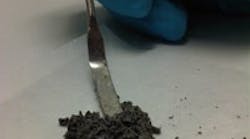Organozinc reagents potentially can play an important role in producing a variety of complex organic compounds. However, susceptibility to degradation from air and moisture has hindered use of such reagents, which only have been available in liquid form. Now, though, researchers at Ludwig Maximilians University (LMU) in Munich, Germany, have developed a simple one-pot method to make salt-stabilized organozinc solids that retain their activity for months when stored in an argon atmosphere (Figure 1). "They can even be exposed to air for short periods without loss of activity," notes Paul Knochel, a chemistry professor who leads the team.
The researchers prepared aryl, heteroaryl and benzylic zinc pivalates under mild conditions and at high yields. The materials, recovered as easy-to-handle powders after evaporation of solvent, show excellent reactivity in Negishi cross-coupling reactions and undergo smooth carbonyl additions, they report in an article in Angewandte Chemie International.
The solids reportedly are compatible with a broader array of functional groups than comparable organolithium and organomagnesium compounds. "Basically, these zinc reagents should be able to undergo cross-couplings with almost all types of organic halides or sulfonates bearing all kind of functional groups (ester, nitrile, nitro, ketone, amines…)," says Knochel.
"This new class of organozinc pivalates makes it possible to employ different solvents in the Negishi cross-coupling reaction and greatly extends the spectrum of coupling partners it can be applied to," notes Sebastian Bernhardt, lead author of the article. "The new reagents contain magnesium salts, which also facilitate the addition of organozinc pivalates to carbonyl groups."
"The organozinc pivalates will be suited to make a range of polyfunctional products which may be of interest as pharmaceuticals, agrochemicals, or useful in materials science. The scope of application will be similar to the one of boronic acids or esters — with the difference that organozinc pivalates are much more reactive in cross-couplings," explains Knochel. "Furthermore, the fact that technical-grade solvents like AcOEt [ethyl acetate] can be used in combination with these organozinc pivalates might make Negishi cross-coupling even more attractive for industry."
A key challenge is to expand structural diversity by including important heterocyclic structures and organic building blocks of general utility, he says. The team also hopes to improve the air stability of the materials. "This is an important property which should make these reagents very practical for synthetic applications in industry and in academia."
The researchers have achieved yields as high as 84%. Fine-tuning of reaction conditions should enable yields exceeding 90%, he believes.
Pilot-scale testing should begin in early 2012, and powders should be commercially available in the spring, Knochel expects. A range of materials should be available within a year, he adds.
LMU has filed a patent application on the synthesis method and currently is negotiating a nonexclusive license to the technology with Chemetall GmbH, Frankfurt.
